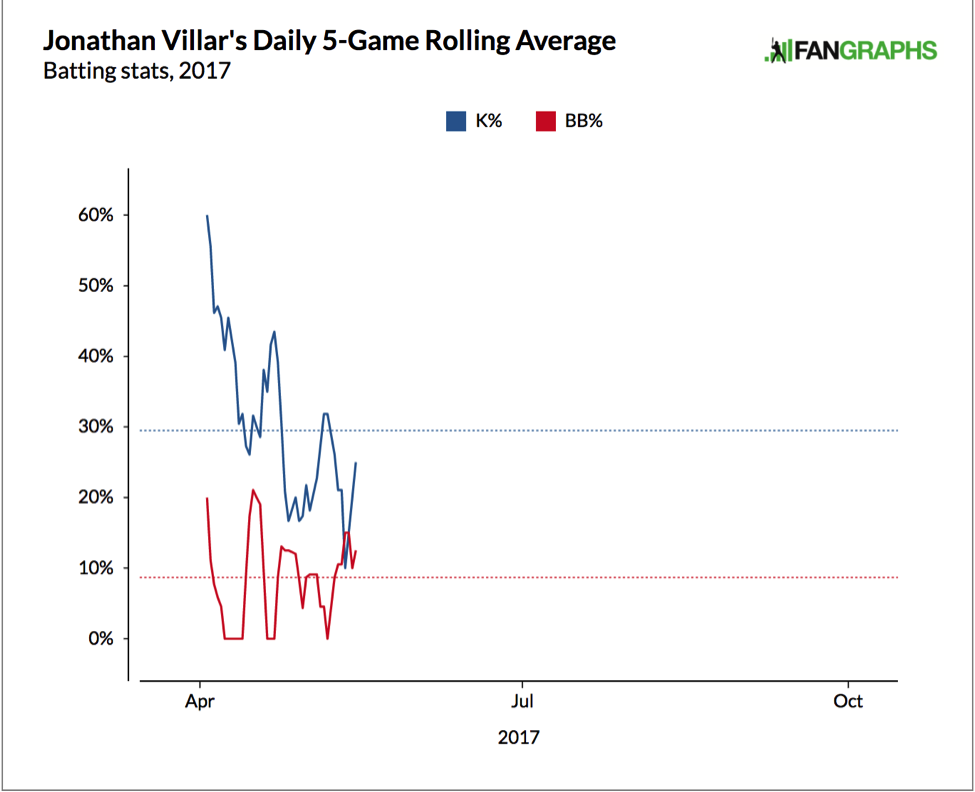Last year, Jonathan Villar was one of the Brewers’ best players and one of baseball’s best stories. He hit .285/.369/.457 and was roughly an average defender at shortstop, which translated into 4.7 WARP. He also led all of baseball with 62 stolen bases. Part of the Brewers’ offseason strategy centered around keeping him in the lineup and on the field, as they traded for Travis Shaw to play third base and designated Scooter Gennett for assignment.
This year, though, Villar has not been good. We’re about a month and a half into the season, so this comes with all the small sample caveats; the fact remains, though, that on a team that ranks second in baseball in runs scored and eleventh in TAv, one of the team’s previous best hitters has simply never gotten going.
Villar has hit leadoff in every game he’s played in, so as a natural consequence he also leads the team in plate appearances. He also ranks last among all the Brewers’ regular starters in TAv; the only position player behind him currently on the roster is Nick Franklin. On one hand, it is remarkable that the Brewers can have been so successful thus far this season without a functioning leadoff hitter. On the other hand, there is a certain point during the season at which this becomes a clear problem.
First, the big picture positives: Villar had an excellent season last year, and he hasn’t been historically awful this season. He is certainly off to a rough start, and his .222 TAv is not ideal. But it ranks ahead of the marks currently being posted by established hitters Joe Mauer and Carlos Gonzalez, and it is in the same general range as Mark Trumbo and Kyle Schwarber. Villar isn’t alone in his struggles, and his month-plus of bad hitting isn’t enough to tank his season. Additionally, Craig Counsell has shown a lot of faith in Villar, and the manager deserves praise for that. It’s easy to imagine that in a different era or with a different manager, Villar would be playing less often or hitting lower in the lineup already. Instead, Counsell is sticking with him, which helps him retain confidence.
But there are obviously still some worrying signs here. Most obviously, despite a zone rate increase of just under two percent, Villar’s swing rate is up nearly five percent and his contact rate is down about two percent. Essentially, Villar is expanding the zone more, and his more frequent swings have resulted in less contact. The contact rate problem isn’t just out of the strike zone, though; his in-zone contact rate in 2016 was 80 percent, while this year it is 78. That may not seem like a huge problem, but it is when combined with other negative indicators like his zone expansion and generally poor overall performance. He is making contact with fewer pitches in the strike zone, and that is the type of trend one expects to see more from an aging veteran than a 26-year-old middle infielder.
Looking for silver linings isn’t all that hard, though. Villar has been heavily criticized for his defense, especially after some noteworthy early-season errors, but the advanced numbers don’t paint that awful a picture. Because we’re so early in the season and defensive numbers take so long to stabilize, I looked at each of FRAA, DRS, and UZR. In both FRAA (0.8) and DRS (1), Villar is a slight positive. In UZR, he is a slight negative (-1.2). I don’t feel comfortable deciding which of the defensive metrics is more accurate, especially after just a month and a half, but those paint the picture of someone who is roughly average at second base. Given that Villar spent most of last year at shortstop and third base, that isn’t an awful outcome.
Additionally, Villar’s plate discipline does seem to be improving. According to FanGraphs’ rolling 5-game graph of Villar’s strikeout rate and walk rate, he has gotten his strikeout problem under control as the season has progressed. He has also been better recently about taking walks, which he struggled with early in the season.
The Brewers deserve credit for sticking with Villar for this long, as there are signs that he may be turning his season around. For any improvements to be permanent, though, he does need to improve his plate discipline. His in-zone contact problem is especially concerning, but the Brewers will have to hope that he does revert to his form from last year.


Maybe Jonathan needs glasses.
I like this theory
Yeah, you’d think they have checked. He should get some Sogard specs…